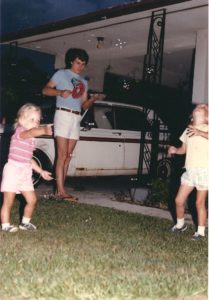After living in Connecticut for a year where my first daughter was born, we thought it would be best for raising a baby girl if we were around my wife’s mother and her sisters, who lived in Florida. We moved back to Florida in 1980 and stayed with my mother-in-law when the baby was about 6 months old. I took my time and found a job that seemed like it had potential for both overtime and advancement, two things I would need since our plan was that my wife stay home and raise our daughter for at least her first few years. We talked about her staying home until the baby was at least enrolled in school. My wife had had a troubled childhood, also, although in a different way than mine; her parents had divorced when she was young. We agreed that we would not raise our daughter the way either of us had been raised. It seemed like a good plan.
By the time our second daughter was born I was working on second shift as a production supervisor and we were renting a house, not just an apartment. My wife went to work part time during the day and was home by the time I needed to go in to work. It was in that house that I solved the Rubik’s Cube one day, sitting in a chair in the living room working through different series of twists and turns while the babies were napping. Bored, mostly. It was also in that house that I noticed we needed to pay more attention to my two-year-old in proportion to the time we were spending with the baby. I guess all parents eventually figure that out. My wife had left the baby in her car seat in the kitchen for just a minute with her big sister watching her. I just happened to come around the corner in time to see big sister holding up an orange she had picked up off the table (in her hand it looked as big as a grapefruit). She was holding it up over her head and was aiming it at the baby when I intervened. I had arrived just in time to avert a small disaster, but I got the message loud and clear. Kids can be so honest.

It seemed like the plan was working.
I used my VA benefits to get into another mortgage and we had a nice little three bedroom house with a fenced-in back yard by the time our first one was out of diapers. It seemed like the plan was working. We used to go for walks around the block with both girls, a dog or two, and the cat following at a safe distance so you wouldn’t get the “wrong impression” and think that she was our cat. Over the next couple of years we had first one daughter riding a bike as we took our evening walk and then eventually both of them. I was very proud of us and was willing to do my part to make it all work. When I came home in the evening there was always an interesting greeting. The girls would have been watching Wild America on public television, their favorite show, and I would be met at the door with their interpretation of whatever animal was featured that day, usually prancing around on four legs but sometimes two. Most of the time, as in the case of meerkats and coati mundis, I had no idea what the animal looked like and only had their version to go by. With no internet and attendant search engines as we have today, they relied on dictionaries, encyclopedias, and story books to educate Dad since he had not been around to see the show. Other times, as with coyotes, I could see the similarities that they were trying to portray because I had lived out west and knew what one looked like.
At bedtime, we were usually watching a show with them. One night, about three or four minutes before the show was over, the last set of commercials started. I suggested that they go get ready for bed during that time and come back to see the last scene. “But Dad,” my oldest daughter said, “we don’t have to go to bed until 8:00.”
I noticed the digital clock sitting on top of the TV. It read 7:57. I let the matter go because they were so good about going to bed when they were supposed to. After they went to bed that night my wife and I talked it over and I was sure they had no concept of the time before the hour because of the digital readout. I asked her if I were to put an analog clock on top of the TV instead of the digital one if she would teach them about the hourly concept of time during their supervised playtime. We both agreed that learning this basic concept about time would be best for them going forward.
At bedtime (they each had their own room) I would spend a few minutes reading a story and saying goodnight to each of them, paying strict attention to whose turn it was to be first that night. When I signed up for and started attending a few college courses again I missed their bedtimes on the nights I had classes and had to make sure that I sat on the edge of each bed for a few minutes when I got home (even though they were sound asleep), again honoring whose turn it was to be first that night. I would try to get home in time for dinner so we could have some consistent family time together that they could look forward to and count on, but even that began to erode when the first micro-computers showed up at work and I was bound and determined to figure out how they could best be applied to my department. Those were some long evenings that launched a whole new career opportunity for me, but they certainly took their toll on my ability to spend time at home.
One evening when my oldest daughter was in first or second grade I was actually leaving work in time to get home for dinner when I noticed Emilio, our security guard, sitting by the doorway reading a newspaper written in Spanish as I was on my way out the front door. I stopped for a moment and commented that I thought that looked difficult to me. He laughed and told me that it was easier than English, which I knew he was learning as a second language. He said you always know how to pronounce a word in Spanish, because the rules were simple and consistently applied, but in English a word could be pronounced using a variety of rules that weren’t very consistent and you didn’t know if you were saying it right unless you looked it up and used the pronunciation key in the dictionary or someone corrected you. I got his point and as I left I was thinking about a consistently applied set of rules for speaking the English language.
At home after dinner, I was sitting on the couch talking to my wife about the conversation I had had with Emilio earlier. I started to talk about the simplified rules for English that I was thinking about on the way home, and gave a few examples. When I was done, she said, “If you use those rules, it won’t be English you’re speaking because no one will be able to understand a word you say.”
The girls had been doing something together on the floor in the living room and the oldest one, who was very good at spelling, had been listening with interest and wanted to go over the rules again. There are only four, and I will go over them here just the way I repeated them to her that night.
- I explained that the first rule comes from the idea that it helps that all vowels in Spanish are spoken with the short sound, like A as in “ah” rather than A as in “tray”. In the new English pronunciation, then, all vowels will always be spoken with the long sound, like A as in “tray” and O as in “grow”.
- The second rule has to do with the fact that in English a consonant can have a hard and a soft sound, like G as in “gorilla” or G as in “George”, and C as in “cart” or C is in “cent”. All consonants will now be pronounced with the hard sound, like G as in “gorilla” and C as in “cart”.
- The third rule has to do with the fact that combining two consonants together can produce a different sound than either hard or soft, like C as in “cherry”. No more. Any consonants that come together in a word will be separated with an “uh” sound in between them.
- The fourth rule is that Y is always a vowel, never a consonant, and is therefore pronounced with a long sound as in “why”.
The word “cherry” and “Cheryl” are good examples because they are affected by all four of the new rules for speaking English. One ends in a vowel and the other in a consonant. Cherry is now pronounced Cuh Hee Ruh Ry, and Cheryl is pronounced Cuh Hee RyL. If something belonged to Cheryl it would then be pronounced Cuh Hee Ry LuhS.
We worked at pronouncing several words in the new manner including the word “language”, which comes out as Lay Nuh Goo ay Gee. When one of the kids asked what would we call this new language, we all settled on the word language pronounced the new way. One of them, and I really don’t remember which, said we should just cal it Lana (Lay Nuh) for short.
We fooled around with it a little bit over the next few weeks, but I only recently learned one of the most interesting parts (to me) of Lana’s history. I didn’t know that while she was in elementary school, my oldest would “play” with this from time to time with her friends, like when they were on the bus. In the early years, only one of the girls she knew ever figured it out. By the time she was in fifth or sixth grade, her and her best friend had become adept at it. When other kids would be speaking the Pig Latin (ig-pay atin-lay) that all kids seem to know or are immediately able to figure out, these two had the ability to speak to each other in Lana. My understanding is that they used it well past middle school and no one could figure out what they were saying! I was then told that when they started taking Spanish in middle school, they came up with something they called Spana that applied consistent rules to speaking Spanish. Lana has a legacy!
So while I was thinking on that evening so long ago that I might actually be revolutionizing the English language, I will settle for having given my daughter and her best friend a social edge in middle school years later. It is obvious that she still has a fond place for it, as well. When she read the rough draft of this story, she said, “Dad! You’re teaching the whole world to speak Lana?”
oh oh PuhS, So Ruh Ry! (oops, sorry)

